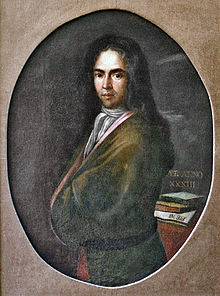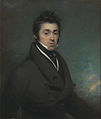Cravat (early)

The cravat is a neckband, the forerunner of the modern tailored necktie and bow tie, originating from 17th-century Croatia.[2]
From the end of the 16th century, the term band applied to any long-strip neckcloth that was not a ruff. The ruff, a starched, pleated white linen strip, originated earlier in the 16th century as a neckcloth (readily changeable, to minimize the soiling of a doublet), as a bib, or as a napkin. A band could be either a plain, attached shirt collar or a detachable "falling band" that draped over the doublet collar. It is possible that cravats were initially worn to hide shirts which were not immaculately clean.[3] Alternatively, it was thought to serve as psychological protection of the neck during battle from attack by a spear.
History
The cravat originated in the 1630s; like most men's fashions between the 17th century and World War I, it was of military origin. In the reign of Louis XIII of France, Croatian mercenaries[4] were enlisted into a regiment supporting the King and Cardinal Richelieu against the Duke of Guise and the Queen Mother, Marie de' Medici. The traditional Croat military kit aroused Parisian curiosity about the unusual, picturesque scarves distinctively knotted at the Croats' necks; the cloths that were used ranged from the coarse cloths of enlisted soldiers to the fine linens and silks of the officers. The sartorial word cravat derives from the French cravate, a corrupt French pronunciation of Croate. Croatia today celebrates Cravat Day on October 18.[5]
Considering the interdependence of many European regions (particularly the French) with the Venetian Republic, which occupied most of Croatian's coast, and the word's uncertain philologic origin, the new male neckdress was known as a cravate. The French readily switched from old-fashioned starched linen ruffs to the new loose linen and muslin cravates; the military styles often had broad, laced edges, while a gentleman's cravat could be of fine lace. As an extreme example of the style, the sculptor Grinling Gibbons carved a realistic cravat in white limewood which is now on display at Chatsworth House.
On returning to England from exile in 1660, Charles II imported with him the latest new word in fashion: "A cravatte is another kind of adornment for the neck being nothing else but a long towel put about the Collar, and so tyed before with a Bow Knott; this is the original of all such Wearings; but now by the Art and Inventions of the seamsters, there is so many new ways of making them, that it would be a task to name, much more to describe them".[6]
During the wars of Louis XIV of 1689–1697, except for court, the flowing cravat was replaced with the more current and equally military "Steinkirk", named after the Battle of Steenkerque in 1692. The Steinkirk was a long, narrow, plain or lightly trimmed neckcloth worn with military dress, wrapped once about the neck in a loose knot, with the lace of fringed ends twisted together and tucked out of the way into a button-hole, either of the coat or the waistcoat. The steinkirk was popular with men and women until the 1720s.
The maccaronis reintroduced the flowing cravat in the 1770s, and the manner of a man's knotting became indicative of his taste and style, to the extent that after the Battle of Waterloo (1815) the cravat itself was referred to as a "tie".
References
- ^ Academia Cravatica
- ^ Academia Cravatica Website
- ^ Coffignon, A. (1888). Paris vivant. Les coulisses de la mode p.104. La librairie illustrée, Paris
- ^ Cravat, die Krawatte
- ^ Heather Horn (October 18, 2012). "The Tie Is a Very Big Deal in Croatia". The Atlantic Cities. Atlantic Media Company. Retrieved 18 October 2012.
- ^ Randle Holme, Academy of Armory and Blazon, 1688.
Gallery
-
French king Louis XIV with an early cravat in 1667.
-
A Regency style neckcloth tied in a bow on a Grafton collar.
-
An image from the 1818 Neckclothitania satirizing different cravat knots.
-
Robert Stewart, Viscount Castlereagh, wearing a cravat
-
An unknown man wearing a cravat in the early 19th century
-
Colonel Isaac Barre wearing a cravat in the mid-18th century
-
Thomas Tooke wearing a cravat in the late 18th century
Se also
External links
 The dictionary definition of cravat (early) at Wiktionary
The dictionary definition of cravat (early) at Wiktionary- The Art of Tying the Cravat (1828) by H. Le Blanc, Esq. (reprinted as ISBN 978-1-145-53416-2)








